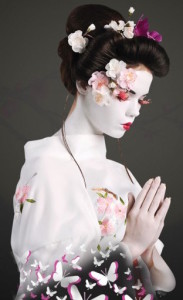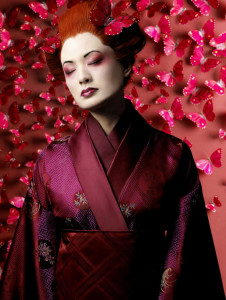What to do about the problem of Madama Butterfly?
It was one of the first operas I ever experienced. When I was newly obsessed with the genre at age fourteen, it was an uncontested favorite. Day after day I listened to the classic recordings (first Serafin, then Sinopoli, then Leinsdorf, then Karajan…) and watched every filmed version available, luxuriating in Puccini’s glorious music, in the beauty of the exotic, blossom-infused setting and in the deliciously heartrending romantic tragedy. Even though I knew Pinkerton was a cad, I projected all my teenage fantasies of romance onto the Act I love duet. This opera was essentially my Twilight.
I suppose I responded to the piece the way a typical white, Western operagoer does. Its reputation as a racist, sexist nightmare only sometimes crossed my mind and I ignored it easily. As a heterosexual female, I never fetishized Cio-Cio-San herself, but I never questioned the idea that her tragic story was “beautiful” either. But now that I’m older and try my best to have a social conscience, I can’t ignore how problematic the work is. I know full well that commentaries on it from a racial or feminist viewpoint, especially from Asian and Asian-American writers, tend to consist of elegantly worded hissing and spitting. They label the character of Cio-Cio-San “a cartoon of submissive Asian femininity” and sometimes even call for the opera to be banned. Its cultural legacy is often blamed for the stereotyping that Asian women face to this day. As a pleasure, it could hardly be guiltier.
Yet it isn’t all bad. By this I don’t just mean that Puccini’s music is stunning regardless of the libretto. From a racial and gender perspective, it isn’t all bad. It’s deeply problematic, of course, but I can’t bring myself to view it as a total cesspit of political incorrectness. As with so many works of fiction from past eras (Carmen is another prime example), its gender roles and racial issues have a fascinating ambiguity. It was this ambiguity that let me enjoy it for years without feeling a trace of white guilt and it’s what keeps it palatable for me today.
Let me start by discussing the problems. Even though Puccini claimed to want to present an “authentic” vision of Japan onstage and incorporated plenty of authentic Japanese melodies into the score, both he and the two librettists were ultimately lazy in that area. The libretto is peppered with invented pseudo-Japanese words and names (e.g. “sarundasico,” “Ocunama,” “Yakuside”), muddles aspects of Buddhism and Shintoism under a broad blanket of “Japanese religion,” and features various other cultural inaccuracies. Butterfly’s relatives, in what little stage time they have, are unflattering comic archetypes (the catty female cousin, the drunken uncle, etc.), while the Bonze is a stereotypically thunderous, intolerant pagan priest so often found in “exotic” operas, and the whole family’s ferocious renouncing of Butterfly arguably evokes the stereotype of Asians as “barbarians.” This stereotype was allegedly more widespread in Puccini’s Italy than today, especially in 1904 when the Russo-Japanese war was raging.
Then there’s Madame Butterfly herself. The archetypal “lotus blossom”; a dainty, beautiful, naïve child-woman who devotes her life to an unworthy white man, gives up her family and culture for him, gives birth to his child, spends three years loyally waiting for him, and then commits suicide when she realizes she’s lost him. Other characters repeatedly call her “little” and the number of times the libretto’s stage directions describe her tones and gestures as “childlike” or “babyish” is hard to count. We can almost hear the collective cringe of Asian women worldwide when she kneels at Pinkerton’s feet during their duet and begs him “Love me, a tiny love, a childlike love…” She’s the stereotypical “good Asian” who loves a Westerner to the point of rejecting her own country, as opposed to “bad Asians” who oppose Western encroachment. The fact that she’s a geisha and a paid temporary “bride” only makes everything worse, encouraging the Western male fetish for Asian women who entertain men, with varying degrees of sex involved, for a living. The fact that she’s both a geisha and a term-bride, even though these were historically two separate institutions, is another sign of lazy cultural research, muddling two different fetishized forms of Japanese female “availability” into one. Icing on the cake is the fact that she’s only fifteen at the beginning, which leads modern writers to castigate Puccini and co. for “romanticizing” the sexual exploitation of a minor.
All of the above issues are real. I won’t deny a single one, no matter how much I might wish I could. But they’re not the sum total of what Madama Butterfly is. Nor do I think every common complaint about the opera is valid. Again and again I’ve read arguments that, no matter how socially sensitive I try to be, feel like nonsense.
First and foremost, the popular claim that the opera encourages Western men to sexually prey on Asian women doesn’t ring true. Pinkerton’s actions are portrayed as wrong! Whether he comes across as a detestable predator or just a reckless fool depends on the tenor, but there’s no question that he’s portrayed negatively. Audiences always loathe him, Sharpless warns him not to do what he does and later views him with disgust, and in the end, lest anyone forget, he loathes himself too. Whether his remorse earns sympathy or disdain as “too little, too late,” it seems unlikely that he’ll ever be a happy man again after he realizes the damage he’s done. Nor do I buy the claim that Butterfly “needs” to be abandoned because a Japanese woman “can’t” be a white man’s real wife, or that her son “needs” to be taken from her because she’s too childish or too much of a sex object to be a mother. What happens to her is portrayed as a devastating tragedy! How can anyone listen to her agonized farewell aria to the child, or the orchestra’s final thundering chords, and assume Puccini was thinking “it needed to end this way – Japanese girls are good for nothing but short flings”?
I’ll admit that the opera has its own “imperialist gaze” even as it condemns Pinkerton’s. There’s no question that the creators wanted people to be enchanted by the setting’s exoticism and to love Butterfly for at least partly the same reasons Pinkerton lusts after her, as an adorably exotic “gossamer creature.” But the idea that they even remotely sided with Pinkerton is total nonsense! While I don’t know if they fully intended the piece to be a scathing anti-American or anti-imperialist tract, it can easily be read that way, and based on what I’ve read about John Luther Long, I’m positive that he at least wanted to condemn naval officers’ “sex tourism” when he wrote the original novella.
(Whether Puccini, Giacosa and Illica – or for that matter, David Belasco when he wrote the play adaptation on which the opera is more directly based than the book – had the same goal or just saw a good story to put onstage, I don’t know.)
Now let’s look at Cio-Cio-San herself: a character who, in my humble opinion and others’ too, is far more than just a one-dimensional “lotus blossom.” Let’s start by giving Puccini and co. the benefit of the doubt regarding whether or not her tragic flaws are meant to be specifically “Japanese.” Because the opera revolves so completely around her, it becomes easy to overlook the other characters, view her as a symbol of all Japan, and accuse the opera of portraying “the Japanese” as naïve, submissive and childlike. But it doesn’t! For all of Goro’s sliminess, the Bonze’s rage, Yamadori’s stiffness, and the relatives’ bad manners and religious intolerance, none of them are naïve or childlike. Nor is Suzuki naïve or childlike – nor does she share any of the other Japanese characters’ unflattering traits, for that matter. She’s a warm, dignified, intelligent woman who has no illusions about Pinkerton, but stays loyal to Butterfly out of sheer devotion, accepts her conversion to Christianity despite being a devout Shinto-Buddhist herself, and effectively serves as an audience surrogate.
With the other characters in mind, Butterfly’s tragic naiveté doesn’t seem to stem from her being Japanese, but from her youth. Fiction is full of naïve young girls who dedicate their lives to the wrong men (as is real life, unfortunately), regardless of race or culture. Granted, Butterfly’s naiveté is slightly larger-than-life in a way that does feel racialized: if she weren’t an “Other,” I doubt the authors would have given her the running gag of mixing up Pinkerton’s initials or have made her ask if American robins nest less often than Japanese ones. But I doubt they were being intentionally racist either.
As for their “romanticizing” a fifteen-year-old’s sexual exploitation, I think that’s just an unfortunate product of time and place, within the opera and without. To this day, the legal age of consent is fourteen in Italy and thirteen in Japan, and when John Luther Long penned the original book, it was as young as ten in some parts of the US. Of course that wasn’t right or justified, but it’s worth remembering that no one within the opera views Butterfly as a statutory rape victim, nor would Long, Belasco, Puccini, his librettists, or any of their audiences have viewed her as such. Nor should anyone who produces the opera today be accused of glorifying affairs between 15-year-old girls and grown men, especially given the tragic outcome.
I’d also like to address the question of whether Butterfly’s self-effacing devotion to Pinkerton is chiefly “Asian” or “Western.” The popular assumption is that it’s meant to be an “Asian” quality, reflecting the submissive ideal of imperial Japanese womanhood. But Butterfly herself doesn’t view it that way! The old law that a husband could divorce his wife just by abandoning her was Japanese; so was the practice of temporary “wives” being sold to foreigners. Butterfly rejects those customs by aligning herself with America, where marriage is sacred and divorce is obtained only through a difficult court procedure. Of course it would be ugly if the authors meant to say “the Japanese casually sell their women and treat marriage lightly; our Cio-Cio-San is chaste and faithful like a good Western girl.” But whether that standpoint is better or worse than “Japanese women are self-effacing wallflowers who blindly worship unworthy men,” and whether the opera really endorses either of those two viewpoints, I’ll let others decide.
The next thing I’d like to observe is that Butterfly is far from blandly fragile or demure. Puccini scored the role not for a delicate lyric soprano, but for a powerful spinto voice. He gave her music that Maria Callas described as “treacherous” and that conveys not only innocence and tenderness, but immense passion and dignity. Nor is she nearly as “submissive” as her detractors label her. She’s submissive to just one person: Pinkerton. Again, because the opera centers around her devotion to him, it’s easy to forget that she submits to no one else. Not to Suzuki: she’s her mistress and behaves as such. Not to Sharpless: she respects him, but only when he treats her as Pinkerton’s wife. Not to her relatives or friends: she commands her own wedding party like a princess, repeatedly telling the guests what to do. Not to Yamadori: his wealth and status mean nothing to her as she gracefully yet shamelessly mocks him. Not to Kate Pinkerton: she forgives her, but insists on giving the child directly to his father, not to her. And certainly not to Goro! Even her loyalty to Pinkerton isn’t just naïve, tender and selfless, but fierce and stubborn!
For a character with a reputation as a wilting lily, it’s astounding how many angry moments she has. She’s prone to outbursts of temper toward Suzuki (not an endearing trait, but a human one). She nearly throws the American consul out of her house when he urges her to marry Yamadori. She even hurls a grown man to the floor and threatens him with her father’s dagger when he claims her son is illegitimate! (Yes, directors often cut that business and have her just chase Goro, pummel his chest with her fists, or some other such thing, but the stage directions call for near-bloodshed!) Arthur Groos, in his writings on the opera, argues that those outbursts are more examples of racial stereotyping; that they portray her as a bit of a “savage.” But even if the authors did just mash together the clichés of “Japanese as barbarians” and “Japanese as dainty and doll-like,” the result they created, whether accidentally or on purpose, was a surprisingly complex heroine.
William Berger, in Puccini Without Excuses, very rightly describes Cio-Cio-San as “a full and complete person” and as “one of the most finely drawn human beings ever to grace the stage.” From the moment she enters, she carries the entire opera both musically and dramatically. We watch her gradually develop from an innocent girl to a tragic, disillusioned young woman, with complex layers of personality (liveliness, delicacy, pride, shyness, passion, joy, hope, fear, anguish, rage, dignity, fragility, steely determination, and even a sense of humor) every step of the way. And while she might be a tragic victim, she’s far from a weakling. She chooses to convert to Christianity, knowingly risking and facing disownment by her family. She stubbornly stays true to Pinkerton for three years, resisting all pressure to remarry or go back to her geisha trade. She raises a baby with little money and only one other woman to help her. When she finally realizes she’s been abandoned, she calmly and bravely agrees to give up her adored son rather than let him live in poverty and shame as a geisha’s mixed-race bastard. Even her suicide can be viewed not as weakness or defeat, but as her bravely reclaiming control of her fate by choosing death over an empty, dishonored life.
This brings us to the last accusation often aimed at this opera: that it promotes the stereotype of Asian women as “sexually available.” Yes, it does revolve around a Japanese girl being sexually sold to an American man. Poverty forced her into the arrangement, because poverty forces women all over the world to make themselves sexually available for money, and it’s precisely those women whom “sex tourists” like Pinkerton target in “exotic” places. It’s probably true that too many fictional Asian women are geishas, concubines or prostitutes. But some people seem to forget that a key aspect of Butterfly is her refusal to be sexually available to anyone but Pinkerton.
In her youthful naïveté, she views her “marriage” as genuine, respectable matrimony, not the prettified prostitution it is. Though she never says so, it can be inferred that she loves Pinkerton not only for himself, but because he “saves” her from the life of a geisha. Nor is her staunch loyalty to Pinkerton just because of love, naiveté, or desire for her son to be raised by his father, but because she would rather die than sell her charms to strangers again. She sings an aria of searing anguish at the thought of having to dance in the streets to feed the child. When Goro labels the boy illegitimate, her rage is vicious. In the end, her suicide explicitly isn’t just out of grief, but to die with honor rather than go back to a life of disgrace. It’s ironic that some people view her as typifying the “Asian women are whores” cliché, when in her short life she only sleeps with one man and chooses death rather than so much as dance for any other.
J.B. Kaufman, in his book about the making of Disney’s Snow White titled The Fairest One of All (a magnificent book for anyone with an academic interest in “children’s” films) discusses the “cult of the child/woman” that thrived in film and theatre during the first half of the 20th century. Snow White, of course, embodies that archetype, and he observes that her personality wavers constantly between “innocent little girl” and “sophisticated young woman,” which he argues makes her one of Disney’s most interesting heroines. His analysis made me think of Butterfly as soon as I read it. Cio-Cio-San is undoubtedly a product of the early 20th century “cult of the child/woman” too, and is characterized by a similar “tension,” even more pronounced than Snow White’s. Tension between the image of the dainty fifteen-year-old “gossamer creature” and the lush spinto voice that exudes mature passion. Between the childlike innocent who giggles behind her fan and begs for love at Pinkerton’s feet and the proud young woman who mocks Yamadori and chases Goro from the house at knifepoint. Between the fragile, pathetic victim and the commanding, dignified tragic heroine. Not only her characterization, but the entire opera thrives on similar “tensions.” For example, the end of the Act I love duet. Both libretto and music clearly contrast Butterfly’s innocent rapture with Pinkerton’s carnal urges, yet Puccini blends them seamlessly together, so beautifully that we almost forget about Pinkerton’s caddishness and believe in their love, or at least understand why Butterfly believes in it.
Does all this ambiguity justify the opera’s popularity? Does it even partially compensate for all the problematic elements? I can’t say; as a white American, I have no right to say. The people who find the piece grossly offensive tend to be Asian or Asian-American and they’re the ultimate authorities on how Japanese culture and characters should be portrayed in fiction. But I at least have the right to point out that the opera isn’t black-and-white where either race or gender are concerned. It’s both a product of its time and slightly ahead of its time, both anti-feminist and proto-feminist, both imperialist and anti-imperialist… in short, it’s thoroughly ambiguous. Will I ever find it as romantic as I did when I was fourteen, with no sense whatsoever of it being a guilty pleasure? I doubt it. But if it’s well staged and well performed by artists who bring forth its ambiguity, in particular a soprano who fully realizes Cio-Cio-San’s dimensions, I can still enjoy it and appreciate just how complex it is.






Lee
March 18th, 2016 at 20:50
A hugely interesting, well-researched and argued article, Jordan – you have addressed all the issues of this marvellous work with a fair hand and non-judgemental eye.
A few observations, if I may ?!
Firstly, which Leinsdorf recording are you referencing at the beginning – the one with Price, or the very different one with Anna Moffo ?!
I agree with about how one’s perceptions of Pinkerton can differ depending upon the tenor’s own ideas. Taking the two Leinsdorf recordings, Tucker is clearly acting out the more selfish aspects of the character; Valletti is the polar extreme – but then that’s all wrong too, as he’s just too much of a wimp to be believable as the character in Act III. In this regard, do you perhaps think Pinkerton is the half brother of the Duke in Rigoletto with the way they can be portrayed?
I’m also mindful of the need to be careful of how perceptions change down the years. Puccini and his librettists may have been guilty of being slap dash or just plain ignorant with their presentation of Japan, but equally so they were too with their presentation of the USA in La Fanciulla (all those “hello, hellos” in the opening scene !). Likewise how “racist” are Shakespeare and Verdi with Othello/Otello ?
For me, the very fact I’m watching something where the actors are singing everything with musical accompaniment, rather than just talking, means I’ve already entered a state of disbelief. So if somebody wants to turn up on a swan, or chop off the heads of anybody who wants to marry them and cannot answer a couple of tricky crossword clues, then that’s just fine by me too – I’m not going to worry too much that !! Maybe I’m being a bit too simplistic here ?
Which isn’t to say that your thought provoking article hasn’t got me rechecking my own thoughts on this work. The problem for me is, however, that my favourite version is Karajan/Decca – and can anyone really dislike Luciano Pavarotti ?!!!
But thank you again – and do excuse me, as it’;s Friday night and I also have had a large glass of wine to celebrate the end of the working week, so am no doubt rambling away !
Warmest regards,
lee
Pamina
March 21st, 2016 at 06:36
Thanks for such a wonderful response!
The Leinsdorf recording I referred to was the Price/Tucker one. It wasn’t my first “Butterfly,” but it was my mainstay recording for ages, to the point that I still tend to automatically hear those singers’ voices in my head when I think of the opera. I own and enjoy the Moffo/Valletti recording too, though.
I agree that Pinkerton could be considered a spiritual half-brother to the Duke of Mantua. I think the Duke is the kind of womanizer Pinkerton wants and fails to be – one who can make conquest after conquest with no repercussions and no remorse. Maybe Pinkerton’s “smallness” by comparison is why audiences always hate him more, even though the Duke is arguably a worse person. That and the fact that we’re made to love and feel for Butterfly so much more than Gilda.
Good insights about “La Fanciulla del West” too. I always try to give authors from past eras the benefit of the doubt about whether any “racism” was intentional, but it especially helps to be reminded that they slightly skewed and caricatured every culture that was “exotic” to them, even if the people were white. There probably aren’t many writers who can write with total accuracy about cultures that aren’t their own.
Lee
March 21st, 2016 at 16:47
Thanks Jordan, as ever, for your kind reply.
We have discussed the issue of “racism” before in Butterfly (on the part of Pinkerton) with regards to the Puccini’s earlier editions of Butterfly. What are your thoughts on Puccini’s revisions of the work whereby he toned this down considerably, as well as adding “addio fiorito asil” to make Pinkerton slightly more sympathetic at the end ?
Warmest regards,
lee
Leyla
March 21st, 2016 at 03:55
Thank you for your thoughtful comments about Madame Butterfly. My husband and I just saw the Sunday matinee of LA Opera’s Butterfly — it’s a GREAT performance! I thought that Ana Maria Martinez’s Butterfly had a great deal of emotional truth — I could absolutely imagine a 15-year-old (Act I) and an 18/19-year-old (Act II). I usually don’t have problems with opera plots because I suspend disbelief and kind of view the plot as whatever (probably unsound) structure the composer cobbled together to carry the emotional truth of the music. But my husband finds the Madame Butterfly plot rather creepy and distasteful. I will try your carefully reasoned argument on him and see whether it might help him with the obstacle that the plot poses.
Pamina
March 21st, 2016 at 06:41
I was there at the same performance! I’ll be reviewing it soon. I wonder if we saw each other?